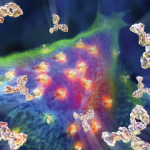1st Identification of ACPAs
It was against this backdrop that Dr. Nienhuis and Dr. Mandema published what is in retrospect a landmark report, “A New Serum Factor in Patients with Rheumatoid Arthritis: The Antiperinuclear Factor.”1 The paper appeared in Annals of the Rheumatic Diseases in 1964. The team took epithelial cells from normal human buccal mucosa and incubated the cells with sera from control patients and from patients with a variety of illnesses, including systemic lupus erythematosus, ankylosing spondylitis and RA. In a subset of RA patients, fluorescence staining revealed a previously undescribed pattern of speckled cytoplasmic fluorescence, often appearing to circumscribe the nucleus.1
Dr. Holers adds, “The authors described an autoantibody that reacted with material in the perinuclear region around the nucleus of the cells at which they were looking.”
Citrullination is one of the processes that appears to be fundamental to inflammation, as well as to many intracellular immune regulatory processes that continue to be identified.
The team called the unidentified factor anti-perinuclear factor (APF), describing the targets as “lying in a plane like the rings of Saturn around the nuclei.” They speculated the reactivity was likely an antibody against kerato-hyaline granules. They identified APF in 48% of patients with rheumatoid arthritis and in less than 1% of healthy controls.1
Notes Dr. Holers, “To me, growing up in rheumatology in the ‘T Cell Era,’ one of the fascinating things is that this finding, despite its reported disease specificity, was not widely studied by investigators as part of the general understanding of the causal disease processes.”
The molecular nature of the epitope recognized by APF remained unclear for some time. In 1979, Young and colleagues described “antikeratin antibodies” that reacted to the keratinized layer of animal epithelium.5 These were found in the sera of a subset of patients with RA (and not in diseased and non-diseased controls). Subsequent studies eventually demonstrated this antibody recognized a similar epitope as APF and that they were potentially directed to the same factor.6 A subset of these autoantibodies was also found to interact with filaggrin (a protein that binds keratin fibers in epithelial cells). An antibody that bound mature filaggrin appeared to be identical to APF, but it was not found in pro-filaggrin taken from cultured cells.7
“The next era of science across the field of autoimmunity was characterized by efforts to identify the antigenic targets, and then characterize those targets,” explains Dr. Holers. “If you look to other diseases, the antigenic targets would be identified; they would be sequenced; they would be cloned; they’d be expressed. People would try to see what part of the protein or protein RNA/protein DNA complex the antibodies reacted with. This RA-related reactivity turned out to be especially interesting, in that it was known to be directed to filaggrin, but if you expressed recombinant filaggrin, you would not see reactivity.”

